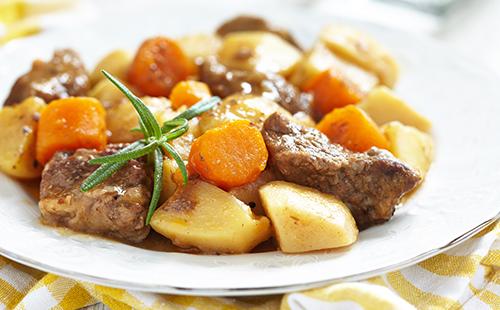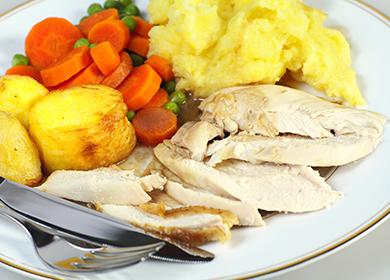The content of the article
The work of a nutritionist on the preparation of special dietary regimes was not in vain. Formed in the middle of the last century, medical "tables" are successfully used by modern physicians. The set of products is changing according to the expansion of opportunities in nutrition. The principles of diets remain unchanged, which ensures the effectiveness of treatment with a special diet.
A therapeutic diet will not only help to reduce weight, it will have a positive effect on metabolism, gradually leading it to a physiological norm. Also, the diet plan is designed to change the patient's eating habits. This will guarantee the stability of weight and prevent its gain in the future.
Who is the number eight medical diet designed for?
Soviet medical diet number 8 is designed to help people with obesity, also suitable for children. Excessive weight is indicated by an excess of 30 by the body mass index. People with a lower index can also use diet rules. Important conditions for applying this nutritional method are:
- moderate physical and mental stress;
- lack of concomitant diseases;
- normal condition of the digestive tract.
The fact is that diet involves the use of foods with reduced energy value. If you eat this way with intense physical or mental stress, the patient will feel weakness and breakdown. Also contraindications include pathology of the digestive tract and other organs. These conditions require observance of special nutritional regimes provided for by Pevzner in the framework of other “tables”.
Among other things, this nutritional system stops weight gain. Its principles can be used by people without obesity who notice a regular increase in kilograms. Indications of diet No. 8 also include impaired lipid metabolism. It can be said about the progression of obesity for no apparent reason.
Weight reduction mechanism
Following a diet implies making serious adjustments to the patient’s eating habits. Its success depends on the unquestioning implementation of the plan, compliance with medical recommendations and the general rules of the restricted diet. The purpose of the appointment of treatment table No. 8 is to force the body to burn accumulated body fat. This will happen under the following conditions:
- reduction in calorie intake - deficiency of calories necessary for the life of the patient, forces the body to take energy from fat depots;
- normalization of lipid processing - this is facilitated by a decrease in the amount of refractory fats in food and an increase in high-density lipoproteins;
- normalization of insulin level - occurs due to the exclusion of simple carbohydrates from food and leads to the prevention of sudden attacks of hunger;
- stomach volume correction - carried out using a fractional diet with a reduced portion size;
- improved lipid metabolism - leads to the efficient use of fats as an energy source, is realized through the use of lipotropic substances;
- overeating exception - occurs due to a decrease in appetite by correcting the taste of food and saturating it with fiber.
The principles of medical weight loss
Diet number 8 (table number 8) will completely transform the way of eating a person who is obese. The presence of a problem with weight already indicates the wrong lifestyle of the patient. A specific approach to the diet will return it to the right track, as well as eliminate the consequences of neglecting one's health.
The eighth table refers to hyponatrium. It involves minimizing the amount of salt consumed. This will remove excess fluid from the body and make fat depots available for natural breakdown.
Reducing the daily amount of free fluid to 1.8 liters will reduce the burden on the heart and kidneys, and will prevent changes in blood pressure. The fluid volume should be reduced correctly:
- sweet soda - to exclude completely;
- alcohol - any alcohol is strictly prohibited;
- liquid dishes - halve the serving;
- tea, coffee, milk - reduce the total number of drinks to four glasses;
- clear still water - makes up the entire remaining volume of liquid.
The total calorie intake is reduced by reducing the amount of bread and fatty foods consumed. Satiety will provide sources of dietary fiber and vitamins - fruits and vegetables. Stability of the insulin level is achieved by excluding simple carbohydrates, as well as starchy foods from the diet.

Speeding up metabolism and decreasing appetite
Compliance with the physiological norm of proteins will help speed up the metabolism and use energy in the process of digesting food. They are digested for a long time, and the process itself requires additional energy from the body. A positive effect on weight loss is the refusal of grated, mucous and pureed dishes. All products are best prepared in pieces. We use recipes with boiling, steaming, baking. Cooking helps to get rid of excess fat and purine compounds in meat products.
To reduce appetite and prevent overeating, you will need to minimize consumption:
- salt (up to 5 g per day);
- pepper;
- mustard;
- horseradish;
- garlic
- Luke;
- strongly smelling seasonings;
- toasted foods;
- alcohol.
Refusal from alcohol is a prerequisite for losing weight - in addition to stimulating appetite, alcohol serves as a source of additional calories.
As part of a fractional diet, the patient is allowed up to six meals a day. It is important to maintain equal spacing between them and portion limits. Food should be healthy and rational in order to prevent the depletion of the body and the appearance of diseases. An important role is given to observing the ratio of proteins, fats and carbohydrates (BJU) in the daily diet:
- 100 g of protein;
- 40 g of vegetable fats;
- 40 g of animal fats;
- 200 g of carbohydrates.

Inventory for the patient
The list of what you can eat on diet number 8 includes only healthy foods. There is no place for sweets and fast food in it. How to fill the refrigerator to comply with table No. 8 is described in detail in the product table.
Table - Products and dishes for the diet table number 8
| Category | Product List | Subtleties of preparation and use |
|---|---|---|
| Bakery products | - Rye bread; - bread with bran; - protein diabetic bread | Use no more than 150 g per day |
| Cereals and pasta | - Barley grits; - buckwheat; - barley; - durum wheat pasta | Add to soups |
| Vegetables and fruits | - All non-starchy and savory vegetables; - sweet and sour fruits and berries | - Prepare all types of dishes from vegetables; - make fruit desserts: jelly, jelly on corn starch; - preference is given to raw vegetables and fruits; |
| Milk and eggs | - Skimmed milk; - any types of dairy products; - limited amount of sour cream; - skim cheese; - 1 yolk and several proteins | - Milk is used to make milk soups; - sour cream is added as dressing for dishes; - unsweetened cheesecakes and casseroles are made from cottage cheese; - the eggs are cooked soft-boiled; - make omelet from proteins |
| Meat and fish products | - rabbit meat; - turkey; - chicken without skin; - veal; - lean beef; - any kind of fish; - all seafood | - The meat is consumed in a boiled piece; - fish is baked after boiling; - prepare fish cakes and meatballs; - seafood is consumed in an amount up to 200 g per day |
| First meal | - Soups on vegetable broth; - milk soups; - dishes on weak fish or meat broth | - Cook on the basis of vegetables; - allowed cereals are added in a minimal amount; - fish and meat dishes are consumed no more than twice a week; - eat half the standard portion (recommended amount); - with severe obesity, the first dishes are not consumed |
Vegetable sources of fat can be added to the list of recommended foods: olivecorn andlinseed oil for dressing salads. Sweeteners are best used as sweeteners. Sorbitol, xylitol, saccharin are suitable for adding to drinks and making diet fruit desserts. Of drinks, weak tea is allowed, preferably green, as well as rosehip broth. It will serve as a source of vitamin C for the body.
Under the ban: what to exclude from the diet
For each diet Manuel Pevzner provides a list of excluded products. It is designed to orient the patient among gastronomic pleasures to prevent the use of obesity provocative products.
- High-calorie flour. It should include first-class wheat flour bread with various additives, as well as any kind of muffin.
- Sources of starch. They include all starchy cereals - semolina, rice, oatmealas well as any kind of bean. Pasta made from soft wheat varieties also provokes obesity.
- Harmful vegetables and fruits. Potatoes and sweet vegetables - beets and carrots can prevent a patient from “giving a fight” to overweight. For the duration of the diet, they should be excluded. Too much sugar is found in all grape varieties, bananas, as well as in all varieties of dried fruits.
- Milk fat. For the duration of the diet, you should abandon fatty milk, cottage cheese, sour cream and cream. It is better not to add milk to drinks, so as not to increase their calorie content.
- Fat meat. Pork and lamb contain refractory fats that contribute to obesity.Observing the medical "table", you should eat only dietary meat. Sausages, fish and canned meat are also considered sources of harmful calories.
The list of what you can’t eat on diet No. 8 automatically includes products of industrial production - snacks, sauces, spicy spreads. All kinds of confectionery and homemade desserts are completely excluded - jam, jam. A very small amount of honey is allowed. It is better to dissolve it in a glass of warm water, intended for morning fasting.

Table: weekly menu
Compiling a healthy diet for one day rarely causes problems. However, a medical diet can last a long time. People who are struggling with obesity will be helped by an approximate diet menu No. 8, compiled for a week, from the following table.
Table - Weekly nutrition plan for diet No. 8
| Days | Breakfast | Dinner | Dinner |
|---|---|---|---|
| Monday | - Boiled chicken breast; - chopped cucumber | - Vegetable soup with buckwheat; - vegetable salad with boiled veal | - Vegetable stew; - a piece of boiled fish |
| Tuesday | - Vegetable salad with boiled meat; - 1 egg omelet | - Borsch on a vegetable broth with a spoon of sour cream; - stewed cabbage | - Canned stewed meat; - slicing fresh vegetables |
| Wednesday | Fresh Tomato and Cottage Cheese Salad | - Okroshka with chicken on whey; - stewed vegetables with veal | - Fish baked with zucchini and pepper; - vinaigrette without beans |
| Thursday | - Seafood based salad; - boiled egg | - Soup on the second fish broth with pieces of fish; - boiled cauliflower under olive oil | - Jellied fish; - side dish of stewed vegetables |
| Friday | - Salad of cabbage and cucumber; - steam fried eggs | - Pickle without salt; - steam chicken meatballs | - Omelet with the addition of ham; - tomato and pepper salad |
| Saturday (fasting day) | Cottage cheese with apple slices | Curd casserole with vegetables | Serving of cottage cheese with berries |
| Sunday | - Sauerkraut with apple under vegetable oil; - soft-boiled egg | - Borsch on chicken stock with pieces of boiled chicken; - seafood salad | - Boiled fish fried in sunflower oil; - vegetable stew |
As a snack fit:
- raw apples;
- low-fat cottage cheese with milk;
- cranberry jelly;
- cottage cheese pudding;
- fresh berries;
- kefir;
- cheesecakes without flour;
- citrus;
- a slice of watermelon or melon;
- baked apple with cottage cheese;
- kefir;
- apples
- berry jelly;
- grapefruit.
Medical table No. 8, like other diets of Manuil Pevzner, should be prescribed by a doctor. The specialist will stipulate individual recommendations regarding the diet and its calorie content. For independent use, you can use the general principles of therapeutic weight loss. Introducing too strict restrictions without good reason is fraught with health problems, as well as exacerbation of chronic diseases.
Reviews
I already wrote my review. Then the term was a month and I threw off from 104 kg to 95. It was from January 25 to February 25. But the weight then stopped. I did not quit the diet. May 25th i.e. in 4 months I lost 23 kg. Now I am 81 kg. I want to lose another 11 kg.
Rina, http://edimka.ru/text/diets/lech8
My doctor prescribed this diet for my daughter. Her weight was 85 kg at 14 years old !!! We were dieting with the whole family as support (a doctor recommended). The result after 6 months, its weight is 64 kg with a growth of 175cm. Plus fasting days to the diet: two days diet.. One day fasting.Unloading days are different: kefir 200g of cottage cheese + 1l of kefir, meat 200g of boiled meat + a bowl of vegetable salad for a day, apple 1.5kg of apples per day
Svetlana http://specialfood.ru/diety/dieticheskij-stol-8-kak-izbavitsya-ot-ozhireniya/

